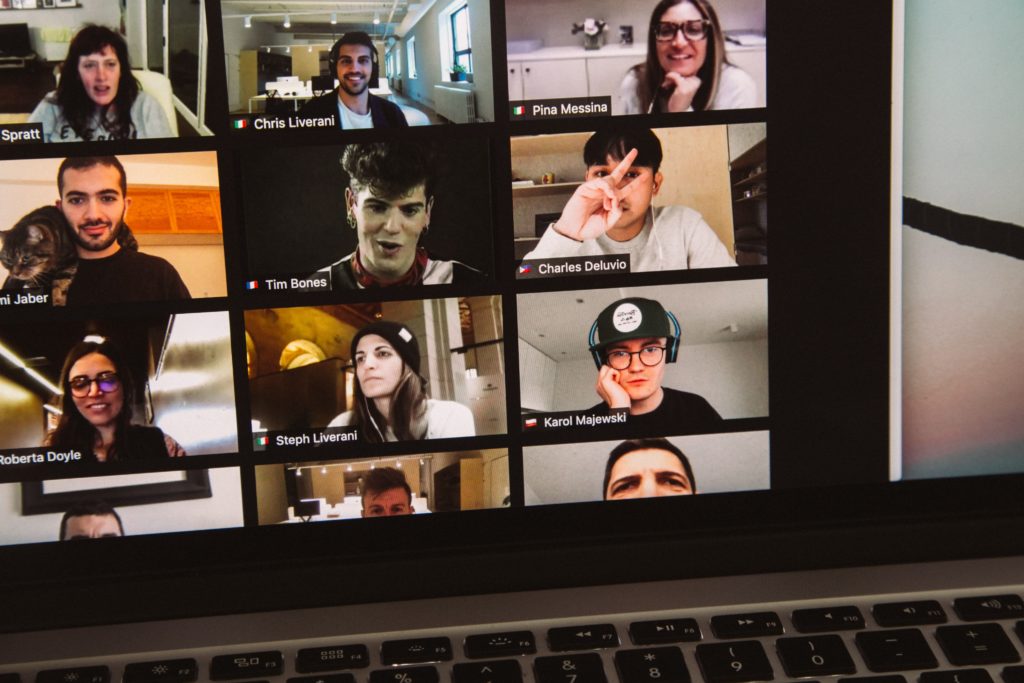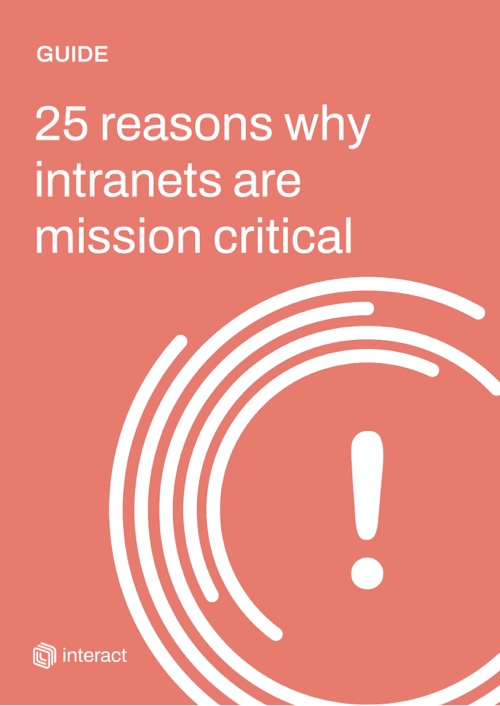Oct 10th marks World Mental Health Day 2020, and right now, reflecting on our mental and emotional health has never felt more important.
This year has been particularly challenging for mental health. Amid redundancies and cuts, employees are struggling to manage the balance of work, relationships, children, and families. While working from home does have its benefits – no commute, casual dress, flexibility – the isolation and loneliness of this pandemic have been devastating for the morale of our workforce.
However, as business leaders, there are things we can do to help. For a large part of the workforce, work has been a welcome distraction in these troubled times. While we’ve felt powerless in the pandemic, our jobs have allowed us to feel some control. When we’ve not been allowed to see friends or family, our colleagues have been a constant. During such turbulence, we’ve managed to keep afloat together.
23 ways your workplace can use a mission-critical intranet to achieve its objectives
But in the long term, we can only imagine the impact that this period has had on our employees. Which is why with Mind’s campaign of Do One Thing, we’re taking the opportunity to look at the small deeds that we can do in our workplace which will help employees feel happier, more supportive and able to be the best they can be.
According to a study of 16,000 people carried out by Mind, more than half of adults (60%) and over two-thirds of young people (68%) said their mental health deteriorated during lockdown. The research showed that many developed new mental health problems as a result of the pandemic and, for others, existing mental health problems worsened.
It rests on our organizations to provide as much help and support as possible to help our employees. And it doesn’t need to be grand gestures. With #DoOneThing we discover how the smallest deeds can have the biggest impact.
1. Say thanks to a colleague

The psychology behind the value of recognition has been well studied, and it’s recommended that all businesses incorporate some kind of recognition program within their workforce. Traditionally, recognition has been top-down: leaders singling out particular individuals for exemplary work and exceptional merit. Nowadays, peer-to-peer recognition is considered equally – if not more – important for staff morale.
Peer-to-peer recognition is 35.7% more likely to have a positive impact on financial results than manager-only recognition.
SHRM Survey
There are countless peer recognition tools available, many incorporated into the company intranet, that encourage colleagues to give shout-outs to each other – thanking them for a job well done or going the extra mile on a project. Virtual tokens can be rewarded to colleagues and cashed in at a later date.
It’s quick, simple, plays a huge role in driving morale, and introduces an element of fun into the intranet. And best of all, gratitude is an emotional contagion: seeing other people’s happiness can increase your own happiness. Having an area of the intranet that solely exists to share good news with the team and highlight hard work is a huge mood booster.
2. Recognition from the top

While you take time out to recognize the achievements of your team during a yearly appraisal, how often do you hand out ad hoc praise? Employee recognition is essential to the happiness of your employees, and key to motivating, retaining, and fully engaging the workforce. Appreciation is also a human need. When employees are recognized for great work, there is a rise in satisfaction, motivation, and productivity. In fact, according to a poll from Gallup, employee recognition is the key factor in employee engagement. Put simply, your workforce requires – even demands – to have their great work recognized and formally acknowledged.
“8 out of 10 Millennials think they deserve to be recognized more for their work – a growing trend.”
Globomore
Yet the same Gallup analysis from 2016 shows that only one in three US workers strongly agree they had received recognition or praise for great work in the past week. The findings saw Gallup consultants recommend that, for those who deserved it, recognition should be given weekly.
23 ways your workplace can use a mission-critical intranet to achieve its objectives
Employee recognition programs are fundamental in promoting greater happiness across your organization. Its home on the intranet means that everyone can be part of this culture of appreciation. And when you have a happy workforce, you also experience improved employee productivity, engagement, retention, motivation, and loyalty. By publicly declaring your employee has done a great job, you not only promote happiness across the organization, but you also reinforce desired behaviors, which are more likely to be repeated as a result.
3. A message from the boss

In times of change or uncertainty, leaders offer a reassuring role.
When workers receive communication from the head of their organization, feelings of anxiety or discontent can be significantly reduced. During the pandemic, this type of contact has helped protect the business from associated implications such as low morale, low staff retention, and reduced productivity. Leadership comms have served a particularly vital role for remote or dispersed workers, who are more likely to feel isolation, loneliness, and disconnect from their organization.
“Three in four employees see communication as the number one leadership attribute.”
Smarp.com
Leaders have long been encouraged to engage directly with their employees. But, it’s also important to strike the right chord when it comes to communication between leaders and staff. Not many workers will be comforted by corporate-speak or industry jargon – this type of correspondence is often worse than no communication at all.
Remote working removes the physical security of being in an office environment, the easy chats between peers, and the presence of leadership. Regular updates from the top give employees working from home a trusted source of truth – something very much needed at the moment.
Consider bringing the boss into smaller or team-based communication on a periodic basis: a Zoom team meeting or a daily project stand-up. These smaller-scale and more personable check-ins with remote-based workers can prove a huge boost for morale. They also provide a less overwhelming setting for individual staff to put forward questions.
4. Huddle

Working together in a small group, or a ‘huddle’ is the everyday norm for departments. Collaboration, feedback, second opinions, conflict, and resolution – these are all second nature in the office and necessary to our work in a team. But remote work removes the ease of the “huddle” – and when this happens, employees miss out on a huge, stabilizing part of their working day. This can negatively impact them and their approach to their work.
“Nearly two-thirds (65%) of knowledge workers collaborate multiple times a day with their colleagues, so encouraging an effective way to improve cohesion within your organization should be a priority.”
Al Fresco
Teams play a really important role in the cultivating of friendships, collaboration, and community. Working together, achieving goals, taking on different opinions, and resolving problems together – for the employee, this is valuable to their sense of belonging and responsibility. In the era of remote working, the physicality ‘huddle’ has been difficult to replicate virtually, and many workers have suddenly been cut adrift as a result. To minimize this, businesses should attempt to recreate this way of working to aid employee happiness and job satisfaction
The conversations and exchange of ideas that happen in the physical workplace should not be underestimated. However, with integrations of chat and video software on the company intranet, employees are instantly connected, able to talk through tasks, and offer help. Huddles should happen every day, not only as a way to streamline work, but also to create that sense of teamwork that the physical office is so adept at fostering.
5. Use team time for fun

While teams also create a bedrock for an employee to grow, they also provide another essential function: fun.
The ability to have fun is so important right now. After six months of lockdown, global anxiety, and health fears, people need to feel they can have a place to be light-hearted. A 2015 study by the University of Warwick’s Centre for Competitive Advantage in the Global Economy found that happier employees were more productive by an average of 12 percent and, in some cases, up to 20 percent more than a control group. This difference is significant, given that “in term so national GDP or economic growth, [productivity] rises of three percent or so are considered very large.”
23 ways your workplace can use a mission-critical intranet to achieve its objectives
Unhappiness is a workplace slayer. When an employee feels low or sad for any reason, motivation drops, they can withdraw, communicate less, and be less productive. In order to look after your colleagues and, ergo, your organization, it is crucial that time, effort, and thought is taken over the many ways you can improve happiness. There is a fundamental need to create fun wherever possible, and appropriate.
“54% of employees say a strong sense of community (great coworkers, celebrating milestones, a common mission) kept them at a company longer than was in their best interest.”
Gusto
And being able to have fun isn’t just beneficial for mental and emotional health. Content employees who have fun at work are more likely to avoid the negative effects of stress and anxiety. Individuals who are able to joke and laugh regularly have shown to have a lower heart rate variability (the time interval between beats) with is associated with a risk of disease.
And fun doesn’t mean necessarily breaking from work. Fun can be incorporated into our daily roles. Playful learning is a vital part of healthy creative development. Just like children, we learn most effectively when we combine a lesson by playing. Our ability to learn improves when the task at hand is enjoyable, and we’re in a relaxed mood. Play can also stimulate imagination, helping people adapt, and problem solve.
The health effects that happiness has on your workforce will also help to reduce absence costs and reduce presenteeism. If your workers are generally healthier as a result of the increased fun they’re having in the office, they are more likely to take less time off due to sickness. Introduce more fun activities into your workplace, and health and wellbeing initiatives, and you should be able to track the positive effect on absence rates via your HR system.
Your intranet can help you host remote team meetings for a weekly pop quiz, a fun show-and-tell about something curious or interesting in a team-mate’s house, or a get together on a TV show you’re all watching. Thirty minutes is the perfect time to set work aside, blow off steam, and learn new things about your team members.
In short, fun is critical to a healthy workforce. We all cope better and recover faster when we’re surrounded by happiness, support, and friendship.
6. Suggest time out

The idea of work-life balance when working from home can often feel erroneous. What with the zero commuting and more time spent at home, you should have the space and time to exercise, rest and catch up on hobbies, right? Not quite: figures that have come out of studies in lockdown suggest we are working longer than normal hours – up to 28 hours a month more. There’s pressure to be seen to be working, and in this time of great economic uncertainty, we want to do as much as we can do to keep our roles and our organization safe.
The research also showed that as well as longer hours, we’re working different hours, with many employees picking work back up in the evenings. After all, with our work desk in our home, and a laptop by our side throughout the day, it’s all too easy to slide back on to it in the evening.
“68 percent of workers believe they are working longer hours at home during the pandemic”
Statista
Working from home and through the pandemic has seen us struggle with this work-life imbalance. The study, commissioned by LinkedIn in partnership with The Mental Health Foundation, found that 56% are feeling more anxious or stressed, 24% are struggling with their mental health, and nearly a third (31%) are having difficulty sleeping.
All this suggests that working from home doesn’t necessarily offer the free-and-easy lifestyle it once purported to. In fact, workers are more at risk of burnout because of the high stakes environment we are currently in globally.
This year has also seen the lowest uptake of annual leave. A report from HR software business BrightHR suggests that 28 per cent of UK workers have cancelled holiday this year. In the months of April and May, when COVID-19 cases in the UK were at their peak, businesses saw the most cancellations of existing annual leave requests.
Which means rather than book time off to remain at home, many employees decided to keep working. There have been many studies demonstrating the health benefits of taking time off work, with holidays being seen as more beneficial to long term health than exercise or diet. When workers have a surplus of holiday allowance still available, this should act as a red flag to employers.
To help this situation, employees need to instill boundaries in their professional and domestic lives, and employers need to promote the taking of annual leave, full lunch hours, and more rigid working hours to discourage the blurring of work and home. Your intranet can be the ideal platform to highlight this need to take breaks, book some days off, and recharge – and underline why annual leave isn’t a luxury, but a priority.
7. Have a one-to-one

Those who are in your direct report need to feel that they have your support, particularly in the current global turmoil. And to do this, they need to hear from you, regularly.
While we can all update each other on tasks and projects, most people won’t talk meaningfully unless it’s in a safe, secure space with someone they trust. Managers must set time up – once a month – to have these catch ups with their workers.
“Only 50% of employees are comfortable discussing mental health issues.”
American Psychiatric Association
One-to-ones are a great morale booster and allow the employee a stage in which to bring up any issues or concerns that they have. With these exclusive conversations, the manager is able to learn more from their worker – and tailor their guidance accordingly.
But it also enables the employee to be able to address any problems, whether it’s professionally or domestically, and look to resolve them with the help of the manager. These meetings strengthen the relationship between manager and direct report and create an exchange of feedback, guidance, and support through these turbulent times.
Use your intranet to host these virtual chats, share notes on the points raised and schedule follow-up conversations.
8. Enable community groups to be created

An intranet is an ideal platform for community groups or an ERG (employee resource group) to come together. This could be an online space for people of shared faith to talk, it could be an organization sports team, or just an area where gamers can talk about their favorite pastime.
On one end of the scale, these spaces act as a voice on a particular issue, (an LGBTQ+ group, women in business, black employee societies, for example), professionally supporting members, and working in partnership with the employer. On the other end, they simply act as somewhere for people to escape the rigors of work and hang out with their colleagues.
“97.57% of UK employees rated extracurricular clubs – such as arts and crafts and book clubs – as the most sought-after perk.”
Perkbox
Either way, they are critical to the wellbeing of certain employees. ERGs help with D&I strategies within the workplace and voice what is working and what isn’t. The more informal groups are still powerful centers of engagement as they help employees cope, those who are isolated, self-quarantining, can be involved socially in some way, even if it is to share their theories on the outcome of the latest Netflix hit series.
9. Host an online wellness area

Think about your traditional office. You might have a prayer room in the building. A gym nearby. A quiet area where people can take time some time out in peace. Our working from home habits may not involve these ‘break out’ areas, but it can easily facilitate them online.
Many companies, both large and small, have been working hard to implement in-office programs that help employees deal with stress, anxiety, and workplace pressures. In addition to cultivating positive work environments, many employers have experience huge workplace improvements thanks to meditation programs. Some offices offer meditation spaces, while others offer guided sessions that help introduce mindful practices into employees’ lives during the workday.
Organizing daily yoga classes, meditation sessions, or at-home workouts can be fundamental to body and mind. During the pandemic, many businesses have implemented online programs such as these to help their employees deal with stress, anxiety, and pressures at work.
One choice is to host self-help and self-care information, such as resources on having healthier intrapersonal communications with yourself.
“89% of workers at companies that support well-being initiatives are more likely to recommend their company as a good place to work“
American Psychological Association
Implementation of these classes will have benefits post-COVID too. Mindfulness programs train the mind to focus. In the fast-moving, tech-focused environment of the workplace, this can undoubtedly improve employee performance and reduce stress and anxiety day-to-day.
Morale may be low at the moment, but we have learned some valuable lessons this year. Specifically, the important role that work plays in all our lives – how it stabilizes us, distracts us, and keeps us moving forwards. However, when employees spend a third of their daily lives working, we – as business leaders – have a responsibility to do what we can to protect their mental and emotional health.
World Mental Health Day gives us the opportunity to assess how we’re achieving this and look at other ways to provide the support and guidance needed right now. Everyone will have unique experiences during this period, but by providing an array of techniques, services, and exercises to cater to different levels of wellbeing, we can create a culture where good mental health is seen as central for everyone.



